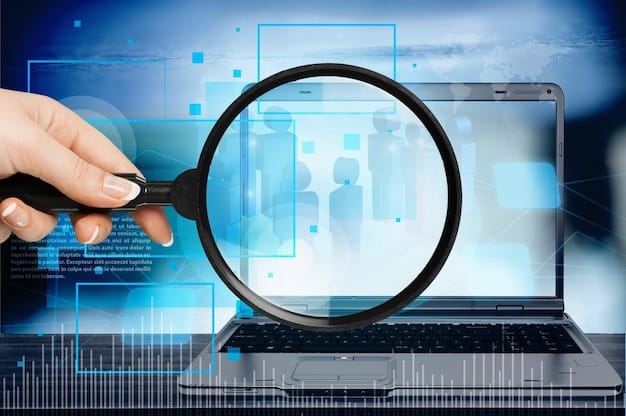Master IRS Form 1099-NEC Reporting for 2025: A Comprehensive Guide

Navigating the updated IRS Form 1099-NEC reporting requirements for 2025 is crucial for entrepreneurs to ensure compliance and avoid penalties, demanding proactive understanding of new thresholds, electronic filing mandates, and enhanced data accuracy protocols.
As an entrepreneur, staying ahead of tax compliance changes is not merely a best practice; it’s a necessity. The landscape of IRS reporting is continually evolving, and the year 2025 brings significant updates to the Form 1099-NEC, specifically concerning nonemployee compensation. Understanding How to Prepare for the Updated IRS Form 1099-NEC Reporting Requirements in 2025 is paramount for maintaining smooth operations and avoiding potential pitfalls with the Internal Revenue Service.
Understanding the Evolution of Form 1099-NEC
The Form 1099-NEC, or Nonemployee Compensation, made a significant return in the 2020 tax year, reclaiming its role from Form 1099-MISC for reporting payments made to independent contractors. This reintroduction aimed to streamline the reporting process and address specific challenges related to deadlines for nonemployee compensation. For 2025, these foundational elements remain, but the IRS is set to introduce further refinements and stricter enforcement mechanisms that warrant close attention from businesses and individual filers alike.
The IRS’s continuous efforts to modernize tax administration and enhance data matching capabilities are at the heart of these updates. The goal is to improve compliance, reduce the tax gap, and ensure that all reportable income is accurately recorded. This evolution means that what worked in previous tax years might not be sufficient for 2025, necessitating a forward-looking approach to compliance strategies.
Historical Context and Its Impact on 2025
Before its resurgence, nonemployee compensation was reported in Box 7 of Form 1099-MISC. The shift back to a dedicated Form 1099-NEC was largely due to differing filing deadlines, which often caused confusion for businesses. The 1099-NEC now has a consistent deadline of January 31, aligning with W-2 forms, which simplifies the reporting calendar for many organizations. These historical changes serve as a precedent for the ongoing adjustments, highlighting the IRS’s commitment to clarity and efficiency, even if it means new adjustments for taxpayers.
For 2025, the underlying principle of separate reporting for nonemployee compensation continues. However, the IRS is expected to tighten requirements around who must file electronically and to what extent data validation will occur at the point of submission. This focus on digital accuracy and timely submission is a direct outgrowth of past administrative challenges and the drive towards a more integrated digital tax ecosystem.
Key Distinctions for Nonemployee Compensation
It is crucial to correctly identify nonemployee compensation to ensure accurate reporting on Form 1099-NEC. This typically includes payments for services performed by someone who is not an employee, such as independent contractors, freelancers, attorneys, or other professionals. Payments for rent, royalties, and other miscellaneous income typically fall under Form 1099-MISC. The distinction is key, as misclassification can lead to penalties and a more complex resolution process with the IRS.
- Services Performed: Payments to individuals or entities for services rendered outside of an employer-employee relationship.
- Minimum Threshold: Generally, payments of $600 or more in a calendar year to one payee.
- Business Context: Payments made in the course of your trade or business, not personal payments.
- State Requirements: Be aware that some states have their own parallel reporting requirements, which might differ slightly from federal rules.
Understanding these distinctions is the first step in preparing for the 2025 updates. The IRS is increasingly sophisticated in identifying discrepancies between different forms and reported income, making accurate initial classification more important than ever.
The return and subsequent adjustments to Form 1099-NEC reflect a broader regulatory trend towards greater transparency and accountability in financial transactions. Entrepreneurs who embrace a proactive stance in understanding and implementing these changes will be better positioned to navigate the evolving tax landscape successfully.
Key 2025 Updates to Form 1099-NEC Reporting
The year 2025 is poised to bring several critical updates to the Form 1099-NEC reporting requirements. These changes are not merely administrative nuances; they represent significant shifts in how businesses large and small must manage their vendor and contractor data, as well as their filing processes. Proactive engagement with these updates will be crucial for compliance and operational efficiency.
The IRS aims to enhance the accuracy and timeliness of reporting, reduce compliance costs in the long run, and streamline its own data processing capabilities. These advancements will demand more robust internal processes from businesses, particularly regarding data collection and storage. Ignoring these shifts could lead to increased risks of penalties and audit triggers.
Mandatory Electronic Filing Threshold Changes
One of the most consequential changes expected for 2025 involves the mandatory electronic filing threshold. Historically, businesses were required to file electronically if they had 250 or more information returns (including Forms 1099, W-2s, etc.). Recent legislative changes have dramatically lowered this threshold to just 10 returns in aggregate. While this was effective for the 2023 tax year (filed in 2024), its full impact will be felt more broadly in the 2025 reporting season. This means that many small to medium-sized businesses previously exempt from e-filing will now be required to do so.
The shift to a lower threshold for mandatory electronic filing underscores the IRS’s push towards digitalization. This isn’t just about convenience; it is about efficiency and accuracy. Electronic filing reduces errors, speeds up processing, and provides a real-time audit trail. Businesses that have traditionally relied on paper filing must now invest in compatible software or services to meet this mandate.
- Lowered Threshold: From 250 to 10 or more information returns in aggregate.
- Impact on Small Businesses: A significant portion of small businesses will transition from optional to mandatory e-filing.
- Required Technology: Businesses will need IRS-approved software or third-party filing services.
- Penalty Avoidance: Failure to comply with the e-filing mandate can result in penalties.
This is arguably the most impactful change for many entrepreneurs, requiring a complete re-evaluation of their filing procedures. Planning well in advance for software acquisition and staff training will be essential.
Enhanced Data Validation and Matching
The IRS is continually improving its systems for data validation and matching. For 2025, a heightened focus on ensuring the accuracy of Taxpayer Identification Numbers (TINs) – typically Social Security Numbers (SSNs) for individuals and Employer Identification Numbers (EINs) for businesses – supplied by payees is anticipated. This means more rigorous checks at the time of submission, and potentially, immediate flagging of discrepancies, rather than waiting for post-filing corrections.

Improved data validation aims to reduce the number of “B-notices” that businesses receive due to incorrect payee information. These notices require businesses to follow up with payees to correct details, a time-consuming and often frustrating process. By validating data more thoroughly upfront, the IRS seeks to minimize these issues for both the agency and the taxpayer.
The implications are clear: businesses must ensure they have accurate and up-to-date W-9 forms (Request for Taxpayer Identification Number and Certification) from all their contractors and vendors. This includes verifying names and TINs against official records. Tools like the IRS’s TIN Matching Program become indispensable for larger operations to pre-validate information before filing.
Potential Changes in State Reporting Alignment
While federal requirements are central, many states have their own independent contractor reporting rules, often linked to federal submissions. For 2025, there’s a potential for increased alignment or, conversely, new divergences, in how states require 1099-NEC data. Entrepreneurs operating across multiple states need to be particularly vigilant.
Some states participate in the Combined Federal/State Filing (CF/SF) Program, which simplifies reporting by allowing the IRS to forward federal 1099 data to participating states. However, not all states participate, and some non-participating states have unique requirements. Businesses should monitor state tax authority announcements closely to understand any new mandates for 2025, especially concerning separate state filings or thresholds.
Navigating these updates requires a proactive strategy that integrates both federal and state compliance considerations. The aim is not just to file correctly but to do so efficiently and without incurring unnecessary costs or administrative burdens.
Proactive Strategies for Data Collection and Vendor Management
Effective data collection and meticulous vendor management are the bedrock of seamless 1099-NEC compliance. As the IRS tightens its reporting requirements for 2025, relying on ad-hoc processes will no longer suffice. Entrepreneurs must adopt proactive strategies to ensure they gather accurate and complete information from all nonemployee service providers well in advance of the filing deadlines.
The foundation of this preparation lies in robust internal policies that dictate how vendor information is requested, verified, and stored. Consider this an ongoing operational task, not merely a year-end scramble. Early engagement with vendors fosters better compliance and reduces the likelihood of last-minute issues that can delay filings and attract penalties.
Implementing Robust W-9 Collection Processes
The W-9 form is your primary tool for collecting accurate taxpayer identification information from your independent contractors and vendors. For 2025, it’s not enough to simply collect a W-9; you must ensure its accuracy and keep it updated. Implement a standardized process for obtaining W-9s from every new vendor or contractor before any payment is issued.
- Pre-payment Requirement: Make submitting a completed W-9 a prerequisite for payment processing for all independent contractors.
- Electronic W-9s: Utilize secure electronic methods for W-9 collection to streamline the process and maintain digital records.
- Annual Review: Conduct an annual review of all vendor W-9s to confirm information remains current, especially if a vendor’s business structure or TIN changes.
- Verification Tools: For larger volumes of contractors, consider using the IRS’s free TIN Matching Program to verify names and TINs against IRS records.
Such a robust system minimizes the risk of incorrect TINs, which are a common source of B-notices and penalties from the IRS. Accurate W-9s are the first line of defense against reporting errors.
Organizing and Maintaining Contractor Payment Records
Beyond collecting W-9s, meticulous record-keeping of all payments made to independent contractors is critical. Your accounting system should be capable of tracking these payments accurately throughout the calendar year. This enables easy aggregation of totals for 1099-NEC reporting.
Ensure your accounting software differentiates between various types of payments to contractors. For example, payments for services should be distinct from reimbursements for expenses, as generally only payments for services are reportable on Form 1099-NEC. Clear categorization prevents accidental over-reporting or under-reporting, both of which can lead to compliance issues.
Regular reconciliation of contractor payments against invoices and W-9 forms can help identify discrepancies early. This reduces the burden at year-end when time is often scarce. Implementing a system for digital record retention ensures that all relevant documents are easily accessible for audits or inquiries.
Establishing Clear Communication with Contractors
Good communication with your independent contractors can significantly ease the 1099-NEC reporting process. Inform them upfront about your W-9 requirements and the importance of accurate information. This helps set expectations and encourages prompt cooperation.
Consider sending an annual reminder to contractors about the upcoming 1099-NEC reporting window and encouraging them to verify their information. This can pre-empt issues before they become urgent problems. Providing clear channels for contractors to update their details, such as an online portal or a dedicated email address, enhances efficiency.
A transparent and collaborative approach with your contractors fosters a stronger working relationship and contributes to a smoother, more accurate tax reporting cycle for everyone involved. It frames compliance as a shared responsibility, rather than a unilateral demand.
Technology and Tools for Streamlined 1099-NEC Compliance
In the evolving landscape of tax compliance, leveraging technology is no longer optional but essential for entrepreneurs. With the lowered electronic filing threshold and heightened IRS scrutiny for 2025, integrating the right tools can transform 1099-NEC reporting from a daunting annual task into a streamlined, efficient process. These solutions automate cumbersome steps, minimize human error, and help ensure regulatory adherence.
The goal is to move beyond manual processes that are prone to mistakes and consume valuable time. Investing in appropriate software and services provides a significant return in terms of reduced risk, increased accuracy, and greater peace of mind, allowing entrepreneurs to focus on core business activities rather than administrative burdens.
Utilizing Accounting Software with 1099-NEC Capabilities
Most modern accounting software solutions, such as QuickBooks, Xero, or Sage, offer integrated 1099-NEC reporting features. These tools can drastically simplify the process by tracking vendor payments throughout the year and then generating the necessary forms with just a few clicks. Ensuring your software is up-to-date with 2025 forms and regulations is crucial.
These systems often allow you to:
- Track Payments: Automatically categorize and sum payments made to contractors.
- Generate Forms: Produce ready-to-file 1099-NEC forms, often in both paper and electronic formats.
- E-file Integration: Provide direct e-filing capabilities or seamless integration with IRS-approved e-filing portals.
- Data Validation: Some advanced features may offer basic data validation checks against W-9 information.
Before the 2025 reporting season, review your current accounting software’s capabilities. Confirm it supports the latest 1099-NEC iteration and can handle the aggregate electronic filing threshold. If not, consider upgrading your subscription or exploring add-on modules that provide enhanced tax reporting functionalities.
Exploring Third-Party E-Filing Services
For businesses that find their accounting software’s built-in features insufficient, or those with a high volume of 1099-NEC forms, third-party e-filing services offer a robust alternative. Services like Track1099, Tax1099.com, or eFileMyForms specialize in information return compliance and are designed to handle complex scenarios efficiently.
These services typically provide:
- Bulk Upload Options: Allow you to upload large datasets of contractor information, eliminating manual entry.
- TIN Matching Services: Often include robust TIN matching to verify payee data before submission.
- IRS Compliance Checks: Perform automated checks to ensure forms meet IRS formatting and content requirements.
- Secure Delivery: Offer options for secure electronic delivery of 1099-NECs to contractors, alongside e-filing with the IRS.
Third-party services can be particularly valuable for entrepreneurs facing the new electronic filing mandate for the first time. They offer expertise and infrastructure that might not be available in-house, significantly reducing the learning curve and potential for errors.
Leveraging Digital Document Management Systems
Beyond the actual filing process, efficient document management is key to holistic compliance. Digital document management systems (DMS) allow businesses to securely store W-9 forms, contracts, invoices, and payment records in an organized, easily retrievable manner. This readiness is invaluable during audits or when responding to IRS inquiries.

A DMS helps ensure that all supporting documentation for your 1099-NEC filings is readily accessible. Cloud-based solutions offer the added benefits of accessibility from anywhere and robust backup protocols, safeguarding your critical financial records against data loss.
Implementing a clear naming convention and folder structure within your DMS for tax-related documents can further enhance efficiency. This systematic approach ensures that you can quickly locate any information required, whether for internal verification or external audits, making year-end processes much smoother.
Navigating Penalties and Avoiding Common Mistakes
Even with the best intentions, errors in 1099-NEC reporting can occur, leading to penalties from the IRS. For entrepreneurs, these penalties can range from minor to substantial, impacting profitability and reputation. Understanding the common mistakes and the associated penalties for 2025 is vital for proactive risk management. The goal is not just to file, but to file accurately and on time.
The IRS imposes penalties for various reasons, including failure to file, late filing, incorrect information, and failure to provide payee statements. The severity of the penalty often depends on how late the filing or correction is and the size of the business. Ignorance of the rules is rarely an excuse that the IRS accepts.
Understanding IRS Penalty Structures
The IRS outlines specific penalties for information return non-compliance, which apply to Form 1099-NEC. These penalties are assessed per form and can add up quickly, especially for businesses with many independent contractors. The penalty amounts are adjusted annually for inflation.
- Failure to File Correctly and on Time: Penalties increase the later you file. The lowest penalty applies if corrected within 30 days of the due date, increasing for filings after August 1st or if no forms are filed.
- Intentional Disregard: If the failure to file or providing incorrect information is due to intentional disregard of the rules, significantly higher penalties apply, with no maximum limit.
- Failure to Provide Payee Statements: Similar penalties apply if you fail to furnish a correct statement to the payee by the deadline.
- Incorrect TINs: If a payee’s TIN is missing or incorrect, and you haven’t made a reasonable attempt to solicit and verify it (e.g., through B-notices), you can be penalized.
The updated electronic filing threshold further complicates matters: if you’re required to e-file and submit paper forms, you could face penalties for non-compliance with the electronic filing mandate, in addition to any other penalty for incorrect or late filing.
Common 1099-NEC Reporting Mistakes
Many reporting errors are preventable with careful attention to detail and robust internal controls. Recognizing these common pitfalls can help entrepreneurs build better defense mechanisms against them.
- Incorrect Payee Information: This is perhaps the most frequent error. Mismatched names and TINs (SSN/EIN) are red flags for the IRS. Always verify W-9 information.
- Missing Forms: Forgetting to issue a 1099-NEC to a contractor who met the $600 threshold. Every qualifying payment needs a form.
- Misclassifying Payments: Reporting expense reimbursements or payments to corporations (which are generally exempt) on Form 1099-NEC.
- Missing the Electronic Filing Mandate: Submitting paper forms when required to e-file, especially with the new aggregate threshold of 10 returns.
- Late Filing: Failing to get forms submitted to the IRS and furnished to contractors by the January 31 deadline.
Each of these mistakes can trigger not only financial penalties but also consume valuable time in corresponding with the IRS and making corrections.
Strategies for Penalty Avoidance
Avoiding penalties requires a multi-faceted approach centered on accuracy, timeliness, and proactive record-keeping. It’s about building a compliance system, not just reacting to deadlines.
- Start Early: Don’t wait until January to begin preparing. Collect W-9s and reconcile payments throughout the year.
- Automate Where Possible: Utilize accounting software or third-party services to track payments and automate form generation and e-filing.
- Verify All TINs: Implement a process to verify contractor TINs against IRS records, especially for new vendors.
- Educate Your Team: Ensure anyone involved in vendor payments or accounting understands the 1099-NEC requirements.
- Keep Detailed Records: Maintain a comprehensive digital trail of all W-9s, payments, and communications with contractors.
By implementing these strategies, entrepreneurs can significantly reduce their exposure to IRS penalties and streamline their 1099-NEC reporting for 2025, ensuring compliance with minimal stress.
Best Practices for Year-Round 1099-NEC Preparation
Successful 1099-NEC reporting in 2025 isn’t just about a last-minute push in January. It requires a strategic, year-round approach that integrates compliance activities into your regular business operations. By adopting a continuous preparation model, entrepreneurs can ensure accuracy, avoid penalties, and significantly reduce end-of-year stress.
Think of 1099-NEC compliance not as an annual event, but as an ongoing process. This shift in mindset allows for systematic gathering of information, verification, and proactive problem-solving, making tax season a smooth culmination of well-managed efforts rather than a frantic race against the clock.
Integrating W-9 Collection into Onboarding
The most effective way to ensure you have accurate W-9 forms for every independent contractor is to make it a mandatory part of your vendor onboarding process. Do not issue a single payment until a fully completed and signed W-9 is on file. This simple policy eliminates chasing down forms at year-end and drastically reduces the chance of missing information.
Consider creating an online portal or using an integrated system where new contractors can submit their W-9 electronically as part of their initial setup. This not only streamlines collection but also immediately digitizes the record, enhancing accessibility and security. Emphasize to contractors that this is a critical step for their own tax reporting as well.
Monthly or Quarterly Review of Vendor Payments
Don’t wait until December to review your vendor payment data. Implement a system for monthly or quarterly reviews. This involves checking your accounting records to ensure that all nonemployee compensation payments are correctly categorized and attributed to the right vendor.
During these reviews, you can:
- Identify Missing W-9s: Quickly spot any contractors for whom you still need a W-9.
- Verify Payment Thresholds: Track cumulative payments to see which contractors are approaching or have exceeded the $600 reporting threshold.
- Correct Discrepancies: Address any miscategorized payments or data entry errors in a timely manner, rather than letting them accumulate.
- Update Contractor Information: Note any changes in contractor business names, addresses, or TINs that require an updated W-9.
These periodic check-ins prevent minor issues from becoming major compliance headaches. They also provide regular opportunities to reach out to contractors for updated information, making those requests less urgent and better received.
Staying Informed on Regulatory Changes
Tax laws, like all regulations, are subject to change. The IRS and state tax authorities frequently issue new guidelines, update forms, and modify thresholds. As an entrepreneur, it’s imperative to stay informed about these potential shifts throughout the year, not just when tax season looms.
Subscribe to IRS newsletters, follow reputable tax news outlets, and consider consulting with a tax professional who specializes in small business compliance. Being aware of proposed changes allows you to adjust your internal processes proactively, rather than reacting to mandates at the last minute.
The 2025 updates to Form 1099-NEC are a clear example of why continuous vigilance is necessary. By making information gathering, record review, and regulatory awareness integral parts of your year-round business operations, you can build a truly resilient compliance framework.
Considerations for Specific Industries and Business Models
While the core principles of 1099-NEC reporting apply broadly, specific industries and business models may encounter unique challenges or nuances for the 2025 updates. Entrepreneurs operating in certain sectors, especially those with a high volume of independent contractors or complex payment structures, need to tailor their compliance strategies accordingly. Understanding these specific considerations can help prevent industry-specific pitfalls.
The variety of services rendered by nonemployees means that the application of 1099-NEC rules can vary. From the gig economy to professional services and real estate, each sector requires a careful interpretation of what constitutes reportable nonemployee compensation and how best to track it.
Gig Economy and Freelance Platforms
Businesses heavily reliant on the gig economy or those operating as freelance platforms face particular complexities. These typically involve a large volume of payments to numerous individual contractors, often for small, frequent transactions. The aggregate nature of the new electronic filing threshold will significantly impact these businesses, potentially requiring all of them to e-file.
- Volume Management: Tools for automated tracking and bulk processing of 1099-NEC forms are crucial.
- Payment Aggregation: Ensure systems accurately sum all payments to a single contractor across various projects or gigs.
- Onboarding Verification: Implement robust digital W-9 collection and TIN verification at the point of contractor signup.
- Platform Responsibility: Understand if your platform itself or the businesses using the platform are responsible for issuing 1099-NECs, as this can vary.
For these businesses, a highly automated and integrated financial system is not just an advantage, but a necessity to manage the scale of their reporting obligations efficiently.
Professional Services (Legal, Accounting, Consulting)
Firms in professional services often engage other professionals as contractors, for example, a law firm hiring a specialized legal researcher or an accounting firm outsourcing specific audit tasks. While payments to corporations are generally exempt from 1099-NEC reporting, payments to attorneys (even if incorporated) are a notable exception and must be reported on Form 1099-NEC if they exceed the threshold.
Additionally, payments for medical and health care services (e.g., to individual practitioners or health care providers) are reported on Form 1099-NEC. Firms in these sectors need to ensure that their accounting systems correctly identify these specific categories of payments and apply the appropriate reporting rules.
The key here is meticulous classification. Differentiating between payments for services, reimbursements, and payments to exempt entities (like most C-corps) requires a clear understanding of IRS guidelines and robust expense coding within accounting software.
Real Estate and Property Management
In the real estate and property management sectors, entrepreneurs frequently deal with independent contractors for maintenance, repairs, renovations, and brokerage services. Form 1099-NEC would cover payments to contractors for services like plumbing, electrical work, painting, or property management fees paid to individuals or non-corporate entities.
It’s important to distinguish these from other real estate-related payments. For example, gross proceeds paid to an attorney in connection with legal services are reported on Form 1099-NEC, but payments of rent to property owners (who are not providing “services” to you) might fall under Form 1099-MISC if they meet the criteria.
Keeping a clear record of all vendor relationships and the nature of services provided is paramount. This ensures that the correct form (1099-NEC, 1099-MISC, or other) is used for each type of payment, minimizing the risk of misclassification and associated penalties for 2025.
Future-Proofing Your Compliance Strategy
The IRS tax code is a living, breathing document, constantly evolving to meet the demands of a dynamic economy. For entrepreneurs, preparing for the 2025 Form 1099-NEC updates is not just about addressing immediate requirements; it’s about building a future-proof compliance strategy. This involves not only adapting to current changes but also anticipating future trends and integrating resilience into your operational framework.
A future-proof strategy recognizes that compliance is an ongoing journey, not a destination. It emphasizes flexibility, continuous learning, and strategic investment in tools and expertise that can adapt to upcoming regulatory shifts, rather than just reacting to them.
Anticipating Further Digitalization and Automation
The trend towards greater digitalization by the IRS is undeniable. The lowered electronic filing threshold for 2025 is a strong indicator of where tax administration is headed. Expect future years to bring further pushes towards mandatory electronic interactions, real-time data submission, and more sophisticated automated checks.
Entrepreneurs should therefore prioritize investments in:
- Cloud-Based Accounting Systems: These offer scalability, robust security, and automatic updates to keep pace with IRS form changes.
- Integrated Compliance Tools: Solutions that connect W-9 collection, payment processing, and 1099-NEC generation remove manual touchpoints.
- Digital Communication Channels: Secure portals for exchanging tax documents and information with contractors.
Embracing a digital-first approach for all financial and tax-related processes will ensure your business remains agile and compliant as the regulatory environment continues to evolve towards full automation.
Building Relationships with Tax Professionals
Even with the best internal systems, tax laws can be complex, and expert advice is invaluable. Establishing a relationship with a qualified tax professional (such as a CPA or enrolled agent) who understands your specific business model and industry can be a cornerstone of a future-proof strategy. They can provide insights into impending changes, interpret complex regulations, and offer strategic advice.
A tax professional can:
- Monitor Regulatory Changes: Keep you informed of any new IRS or state mandates that could impact your 1099-NEC reporting.
- Provide Guidance: Help you navigate ambiguous situations regarding contractor classification or payment types.
- Assist with Audit Defense: Represent you and provide support should your business be subject to an IRS audit.
- Optimize Compliance: Ensure your strategies are not just compliant, but also tax-efficient within the legal framework.
Consider regular check-ins with your tax advisor, perhaps quarterly, to discuss any business changes, new vendor relationships, or potential reporting challenges. This proactive consultation is far more effective than seeking help only when problems arise.
Implementing a Culture of Continuous Learning and Adaptation
Ultimately, future-proofing your compliance strategy boils down to fostering a culture within your organization that embraces continuous learning and adaptation. This means:
- Regular Training: Ensuring that anyone involved in financial operations stays updated on tax regulations.
- Feedback Loops: Establishing channels to identify and address compliance pain points or gaps within your processes.
- Agile Strategy: Being prepared to quickly integrate new technologies or adjust workflows in response to new IRS requirements.
The entrepreneurial journey is marked by constant change. Those who view tax compliance as an integral, dynamic part of that journey, rather than a static annual chore, will be best equipped to navigate the updated 2025 Form 1099-NEC requirements and beyond, safeguarding their business for the future.
| Key Point | Brief Description |
|---|---|
| 📝 Electronic Filing | Mandatory for 10 or more forms (aggregate) for 2025 filings, impacting many small businesses. |
| ✅ Data Accuracy | Heightened IRS focus on accurate TINs and payee information, requiring robust W-9 processes. |
| 📅 Year-Round Prep | Continuous W-9 collection and payment tracking throughout the year prevents year-end rushes. |
| 💡 Technology Use | Leverage accounting software and e-filing services for automation and streamlined compliance. |
Frequently Asked Questions about 2025 1099-NEC Reporting
The primary change affecting most small businesses for 2025 reporting is the reduced mandatory electronic filing threshold. Businesses must now e-file if they have 10 or more information returns in aggregate, a significant drop from the previous 250-form threshold.
Verifying W-9 information (especially names and TINs) is crucial because the IRS is increasing its data validation checks. Mismatched or incorrect information can lead to penalties and “B-notices,” causing administrative burden. Proactive verification prevents these issues.
You can only file paper 1099-NEC forms if you are reporting fewer than 10 information returns in total across all types (e.g., 1099s, W-2s). If you meet or exceed the 10-form aggregate threshold, electronic filing is mandatory by law.
Nonemployee compensation refers to payments for services performed by someone who is not your employee, like independent contractors or freelancers. A 1099-NEC generally needs to be issued if you pay an individual or non-corporate entity $600 or more in the course of your trade or business.
To avoid penalties, consistently collect accurate W-9s before paying contractors, track payments meticulously, use appropriate accounting software or e-filing services, and meet the January 31st deadline for both the IRS and recipient copies.
Conclusion
The journey to mastering the updated IRS Form 1099-NEC reporting requirements for 2025 transcends mere compliance; it’s an opportunity for entrepreneurs to refine their financial operations and bolster their business’s resilience. By embracing a proactive posture, focusing on meticulous data collection, leveraging technological advancements, and staying continuously informed, businesses can transform what might seem like a regulatory burden into a streamlined, efficient process. These updated requirements, particularly the lowered electronic filing threshold, underscore the IRS’s commitment to digital transformation, urging every entrepreneur to adapt and evolve. Preparing effectively isn’t just about avoiding penalties; it’s about building a robust, future-proof financial infrastructure that safeguards your enterprise in an ever-changing regulatory landscape.





